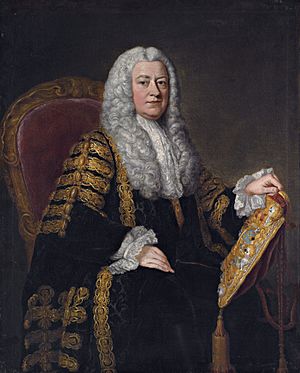Heritable Jurisdictions (Scotland) Act 1746 facts for kids
| Act of Parliament | |

|
|
| Long title | An Act for taking away and abolishing the Heretable Jurisdictions in Scotland; and for making Satisfaction to the Proprietors thereof; and for restoring such Jurisdictions to the Crown; and for making more effectual Provision for the Administration of Justice throughout that Part of the United Kingdom, by the King’s Courts and Judges there; ...and for rendering the Union of the Two Kingdoms more complete. |
|---|---|
| Citation | 20 Geo. 2. c. 43 |
| Territorial extent | Kingdom of Great Britain |
| Other legislation | |
| Relates to | Acts of Union 1707 |
|
Status: Current legislation
|
|
| Revised text of statute as amended | |
The Heritable Jurisdictions (Scotland) Act 1746 was an important law passed in Great Britain. It came after the Jacobite rising of 1745, a big rebellion in Scotland. This Act took away special legal powers that Scottish landowners, called heritors, and especially clan chiefs, used to have. These powers were a huge source of control over the people who lived on their land.
Before this Act, many of these legal roles, like that of a sheriff-principal, were passed down through families. Even though the King was supposed to appoint them, most had become hereditary. The people who held these inherited roles would hire legal experts to do the actual court work. The 1746 Act changed this, giving control of these important legal jobs back to the King.
Because the Acts of Union (which joined Scotland and England) said these powers were like private property, the landowners who lost them were paid money as compensation.
Why Was This Law Created?

The main goal of the Heritable Jurisdictions Act was to make justice fairer across Scotland. It aimed to remove the old, inherited legal powers. The law wanted to give these powers back to the King's courts and judges. This would make sure everyone in Scotland was treated equally under the King's laws. It also aimed to make the union between Scotland and England stronger and more complete.
The government believed that having many different inherited legal systems caused problems. They wanted to fix this by giving the King's courts more influence. This would protect all of the King's subjects in Scotland better.
A Look Back: The Act's History

This Act was one of several laws passed after the Jacobite rising of 1745 was defeated. These laws aimed to reduce the traditional power of Scottish clan chiefs. Other laws included the Dress Act 1746, which banned Highland dress, and the Act of Proscription 1746, which tried to control the clans.
Inherited legal rights were common throughout Scotland, not just among clan chiefs. There had been earlier attempts to limit these powers. For example, in 1692, a change to the Church of Scotland took away the right of landowners to choose church ministers.
However, many of these powers remained. One of the most important was the control over the 33 Sheriffs who ran the Scottish court system. In 1745, only eight of these Sheriffs were chosen by the King. Three were appointed for life, but the rest were hereditary. The people who owned these hereditary roles hired legal professionals, called Sheriff-substitutes, to do the actual work. These substitutes often earned money by taking a percentage of the fines they gave out.
The 1746 Act gave the King full control over appointing Sheriffs. It also moved the role of a "Justiciar" (a high judge) to the High Court of Justiciary. Since these inherited powers were seen as private property under the 1707 Act of Union, their owners were paid for them. However, people who had supported the Jacobite rebellion were not paid.
A total of £152,000 was paid out in compensation. The largest payments went to the Duke of Hamilton (£38,000) and the Duke of Argyll (£25,000). Sir Andrew Agnew, who was the hereditary Sheriff of Wigtownshire, received £4,000. This was because he had supported the government during the 1745 rebellion.
Lord Hardwicke, who helped create the Act, argued that the King needed to control these powers. He believed that people would follow whoever had the power to help or harm them. So, he felt it was important for the King to have this power, not private individuals.
The Prime Minister, Henry Pelham, thought this Act was the most important step to deal with Jacobitism in Scotland. Most parts of the Act have since been removed or changed. But it still says that any noble title created in Scotland after June 6, 1747, can only give rights related to being a landlord (like collecting rent).
The very last parts of the old feudal system in Scotland ended with the Abolition of Feudal Tenure etc. (Scotland) Act 2000. This law came into effect in 2004.
See also


